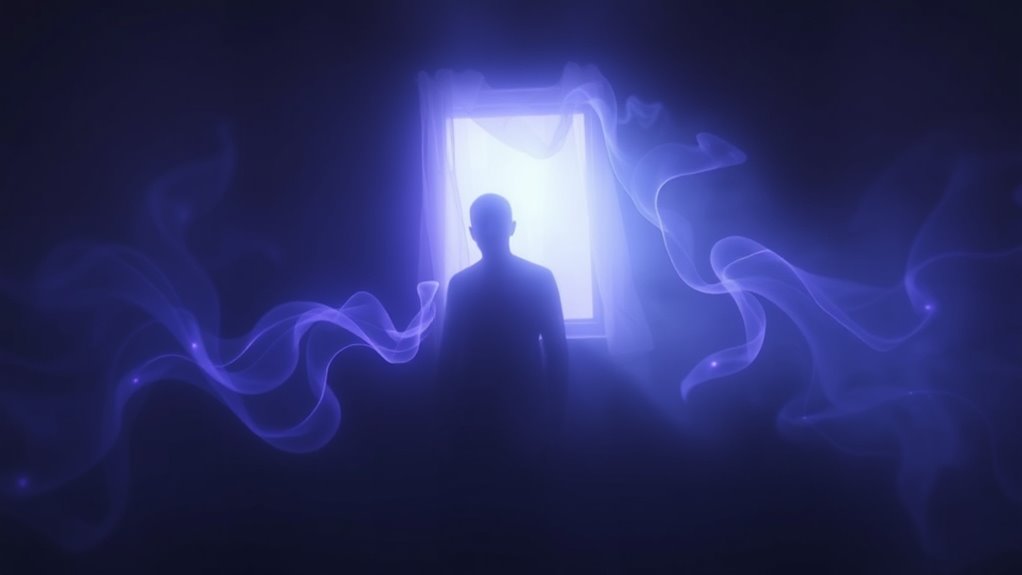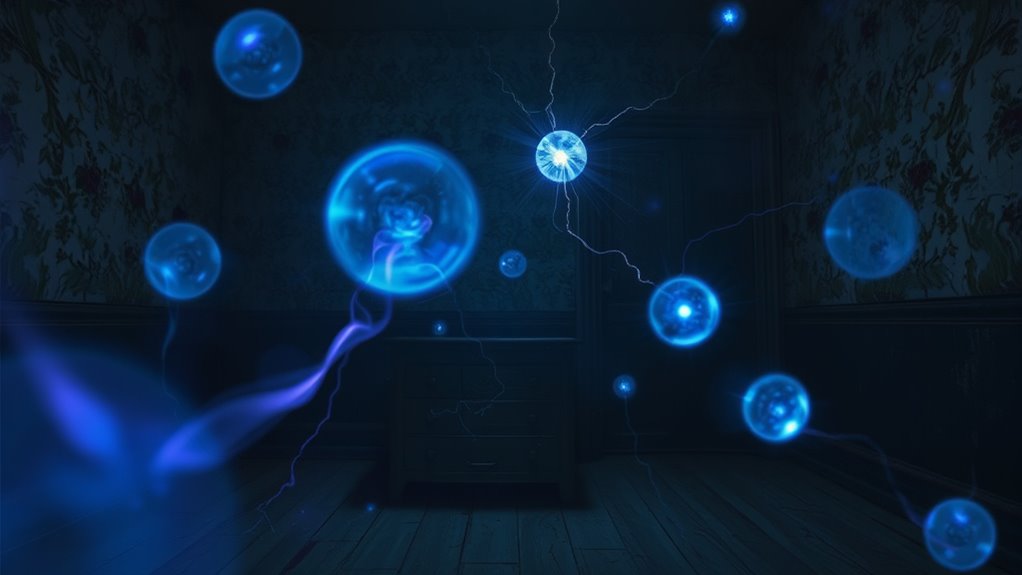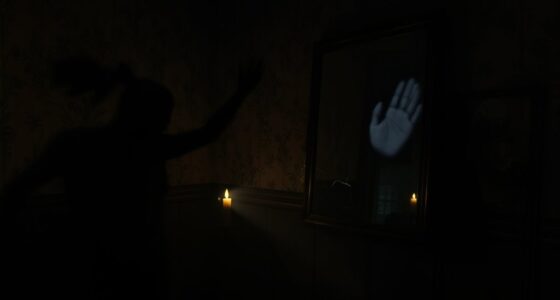Electromagnetic fields can stimulate your brain in ways that create vivid hallucinations, making you see ghosts, hear voices, or sense presences without any real source. These signals interfere with your neural activity, tricking your brain into perceiving things that aren’t there. Situations with high electromagnetic activity, like near power lines or electronic equipment, can increase these experiences. If you’re curious about how this happens and what causes these effects, there’s more to discover below.
Key Takeaways
- External electromagnetic fields can stimulate brain regions, causing sensory perceptions that may be mistaken for ghosts or supernatural entities.
- Electromagnetic interference disrupts neural activity, leading to vivid visual or auditory hallucinations without real-world sources.
- Environments with high electromagnetic activity, like power lines or electrical equipment, increase the likelihood of experiencing electromagnetic hallucinations.
- Such hallucinations mimic paranormal phenomena but are actually caused by neural stimulation from electromagnetic interference.
- Understanding electromagnetic influence helps explain ghost sightings and voices as sensory illusions rather than supernatural occurrences.

Electromagnetic hallucinations occur when the brain perceives visual or sensory images triggered by external electromagnetic stimuli, even in the absence of real-world sources. When your brain experiences neural stimulation from these fields, it can create vivid sensory illusions that feel incredibly real. You might see ghostly figures, hear strange noises, or sense presences that aren’t actually there. This happens because electromagnetic fields can interfere with your brain’s electrical activity, disrupting normal neural processes and leading to false perceptions.
Your brain is highly sensitive to electromagnetic signals, which can influence neural pathways responsible for processing sensory information. When external EM fields fluctuate or intensify, they can stimulate neurons in specific areas of your brain, mimicking signals that would typically originate from actual sights or sounds. This stimulation tricks your brain into interpreting these signals as real sensory inputs, resulting in hallucinations. In other words, what you see or feel isn’t an external apparition but a sensory illusion created by your brain’s response to electromagnetic interference.
External electromagnetic fields can stimulate your brain, causing sensory illusions and hallucinations that feel real.
Recent studies suggest that neural interference caused by electromagnetic fields may contribute to various sensory disturbances, highlighting the complex relationship between environment and perception. This phenomenon is especially relevant in environments with high electromagnetic activity, such as near power lines, electrical equipment, or strong magnetic fields. In these settings, you may notice unusual visual or auditory experiences without any logical source. These experiences are not just random; they are a direct consequence of how electromagnetic fields can induce neural stimulation that mimics genuine sensory signals. Your brain, attempting to interpret these signals, produces the illusion of seeing ghosts, hearing voices, or sensing presences—phenomena often associated with paranormal activity.
Understanding this link between electromagnetic fields and sensory illusions can help demystify some experiences that previously seemed supernatural. It’s not that ghosts are necessarily present; rather, your brain might be reacting to electromagnetic interference in a way that produces these vivid hallucinations. This insight reveals that electromagnetic stimulation can evoke perceptions similar to those caused by psychological or neurological conditions, but in this case, the trigger is external EM fields. Recognizing these effects underscores how sensitive your brain is to environmental influences and how electromagnetic stimuli can manipulate perception.
Frequently Asked Questions
Can Electromagnetic Fields Cause Physical Sensations Alongside Visual Hallucinations?
You might wonder if electromagnetic triggers can cause physical sensations alongside visual hallucinations. The answer is yes; strong electromagnetic fields can induce sensory distortions, leading to physical sensations like tingling or pressure. These sensations often accompany visual hallucinations during electromagnetic disturbances. Such effects suggest that electromagnetic fields can influence your nervous system, creating a combination of visual and physical experiences, especially in environments with high electromagnetic activity.
Are Electromagnetic Hallucinations More Common in Certain Age Groups?
Think of your mind as a garden that’s more prone to weeds at certain seasons. Age-related susceptibility plays a role, with children and older adults often more vulnerable due to developmental differences in brain plasticity and sensory processing. Younger brains are still growing, and aging can alter neural responses, making certain age groups more prone to electromagnetic hallucinations. So, yes, some ages are more susceptible than others.
How Do EM Field Strengths Correlate With Hallucination Intensity?
You might notice that as EM field strengths increase, neural interference causes more intense sensory distortion. Stronger electromagnetic fields can disrupt normal brain activity, leading to vivid hallucinations or visual distortions. The correlation suggests that higher EM field strengths amplify hallucination intensity by interfering with neural signals, making you more likely to experience strong sensory distortions. So, the stronger the EM fields, the more profound and vivid your hallucinations could become.
Can Electromagnetic Therapy Be Used to Treat Hallucinations?
Think of electromagnetic therapy as a double-edged sword you hold in your hand. It can potentially modulate brain activity to reduce hallucinations, but you need to contemplate neuroplasticity implications—how your brain might adapt or change. Ethical considerations also come into play, ensuring safety and consent. While promising, you should consult health professionals to evaluate if this treatment fits your specific needs, balancing hope with caution.
Are Electromagnetic Hallucinations Linked to Specific Mental Health Disorders?
You might wonder if electromagnetic hallucinations are tied to mental health disorders. They can indeed be linked, as neurochemical disruptions and altered sensory processing often contribute to hallucinations. Conditions like schizophrenia, bipolar disorder, and severe depression sometimes involve these disruptions, leading individuals to experience visual or auditory hallucinations. While electromagnetic fields alone aren’t direct causes, they can influence brain activity, potentially exacerbating existing mental health symptoms.
Conclusion
So, next time you feel a strange chill or see a fleeting shadow, remember electromagnetic fields might be at play, making your mind conjure ghosts like some modern-day Merlin. While it’s tempting to believe in spirits, science suggests these sensations could simply be your brain reacting to unseen EM influences. Don’t worry—you’re not losing your mind or living in a Victorian ghost story; sometimes, it’s just the power of science, not spirits, shaping your reality.









